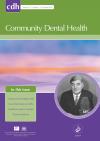Community Dental Health

- Cover Date:
- December 2016
- Print ISSN:
- 0265 539X
- Vol:
- 33
- Issue:
- 4
The use of diet diaries in general dental practice in England
Objectives: Diet diaries are recommended as a tool to support behaviour change in dental patients at high risk of
dental diseases. However, little is known about their use in dental practice. This study aimed to investigate whether
and how general dental practitioners (GDPs) use diet diaries and identify factors which influence their use. Methods:
A postal questionnaire was sent to a stratified random sample of general dental practitioners. The questionnaire asked
about demographic and professional characteristics of the GDPs and their practices regarding diet advice, collection of
dietary information, diet diaries usage (e.g. frequency, considerations and barriers), and interpretation of diet diaries. Descriptive, bivariate and multivariate analyses were conducted. Results: From 972 eligible GDP participants, 250(26%) responses were received. Whilst almost all of these GDPs reported giving diet advice to patients routinely,
and 40% reported also referring to dental care professionals in the practice to deliver dietary advice, only 28% (70)
reported that they are involved in using diet diaries. GDPs appeared to target patients for dietary advice: GDPs
reported they personally gave diet advice to an estimated 63% of their patients, and referred patients to DCPs for
diet advice for 11% of their (GDPs’) patients. GDPs used diet diaries more often for child than adult patients. Diet
diaries usage was lower among younger dentists and in practices with higher percentages of NHS patients (p<0.05).
Perceived insufficient remuneration for time involved in using diet diaries was the main reason given for their lack
of use. Conclusion: Although recommended as best practice, most English GDPs do not frequently use diet diaries
to collect diet information in dental practice, mainly due to perceived financial and time constraints. Development of
a more efficient tool to assess the dietary habits of dental patients is needed.
Key words: diet, dental practice, health education, caries, diary, England
doi:10.1922/CDH_3928Arheiam07
- Article Price
- £15.00
- Institution Article Price
- £
- Page Start
- 267
- Page End
- 273
- Authors
- A. Arheiam, S.L. Brown, G. Burnside, S.M. Higham, S. Albadri, R.V. Harris
Articles from this issue
- Title
- Pg. Start
- Pg. End
- An intervention study to assess the effectiveness of a reminder telephone call in improving patient appointment attendance at a Community Dental Service clinic
- 239
- 241
- Patient characteristics in relation to dental care payment model: capitation vs fee for service
- 252
- 256
- Psychometric properties of the English version of the Oral Health Literacy Adults Questionnaire - OHL-AQ
- 274
- 280
- Approximal caries increment in relation to baseline approximal caries prevalence among adolescents in Sweden with and without a school-based fluoride varnish programme
- 281
- 285
- Variation in methods used to determine national mean DMFT scores for 12-year-old children in European countries
- 286
- 291
- The relationship between maternal smoking during pregnancy and parental-reported experience of dental caries in Indigenous Australian children
- 297
- 302
- Dental problems and Familismo: social network discussion of oral health issues among adults of Mexican origin living in the Midwest United States
- 303
- 308
